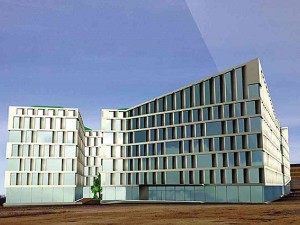
AS A PLUG-IN for rendering software, VuFrame combines 3D visualization and augmented reality technology. With a plug-in like this, professionals are able to produce images that can move around allowing end-users to experience the depths and dimensions of a project within their real environs. Photo from VuFrame.com
Merriam Webster defines it as “an enhanced version of reality created by the use of technology to overlay digital information on an image of something being viewed through a device.” In practical terms, augmented reality is taking an image or video of your real-world environment plus new visual information, and putting them together onto your digital device’s screen. Hence the term “augmented reality,” or AR to the geeks.
We had a term for a similar technique during the nondigital design world’s lost era: “Photo-montage.” This is when we took a hand-drawn image of a building and stuck it onto the photo of its future site. Then we ran it through a laser copier to print a single sheet image that showed the new project in its “true” environs. But that wasn’t in real-time. And not at all digital. Photo-montage is still being executed but via pixels and not pen strokes, and sometimes, executed and viewed in real-time.
Pop-up windows
My first encounter with augmented reality was via a pop-up window in a fashion magazine site. It prompted you to choose from a dozen or so hairstyles, and drag it to the crown of your head in the photo you took with your computer’s camera just minutes ago. Augmented reality’s functions and capabilities have since developed from simple hairstyling pop-ups. The technology has been integrated into games, plug-ins for professional rendering software, directional radar mapping of places, and 3D model generation for educational apps.
A few weeks back, I was toying with an app called “Magic Plan,” which allows you to measure a room that you’re in via your device’s camera. You then insert furniture pieces into the digital layout so that you can immediately visualize the floor plan of a room. But this was a two-dimensional process, and so that third dimension—height—was missing, making it a little difficult to truly visualize the space.
Another app called “uDecore” allows you take a photo of your space and drag virtual furniture pieces from its library of more than 200 pieces. Finding the styles you particularly want may be a little tough: Aside from being quite cartoonish and lacking in detail, the pieces are not necessarily readily available. Moreover, the pieces in the library were limited in design and a bit outdated.
Preferred hue
“Augmented Colors” allows you to pick up any color by merely pointing and clicking a preferred hue from anything around you. The app converts it into a digitally defined equivalent of the RGB mix. Quite helpful, but how you perceive the color will depend on the level of light during the point and shoot moment, and how you view it will depend on the quality of your camera and monitor.
In a way, augmented reality brings pieces of a puzzle together so that options may be viewed, decided upon and realized very quickly. However, it often lacks true representation. Viewing through a screen can distort one’s perspective of the visual field, if not for the general “real” background then for the “augmented” fragment of the image. Moving through a space via the monitor of your device produces a very different experience: insufficient in the details of light, shadow, depth of field and perspective. Leave a margin for error when making decisions based on digital images.
Innacurate
Augmented reality takes a little bit of getting used to. I still have spaces measured with a measuring tape and two warm bodies despite the “Magic Plan” app, as the latter is not as accurate. Coming up with photo-real digital images for design projects and presentations are still dishearteningly inaccurate, and only become more truthful when the app itself processes a substantial amount of information to make it photo-real. A lot of work from the end of the human, and less from the machine.
AR can turn you into a giddy, excited child, caught up in the thrill of exploring a new platform with instantaneous visualization. But taking a second glimpse separates the fiction from the reality. AR has a long way to go in terms of faithfulness. But for all its faults, it is a huge leap forward, and as processors and video cards become faster, we will soon see the images on our monitors refining into life-like representations of our environs.
Contact the author through designdimensions@abi.ph or through our Asuncion Berenguer Facebook account.